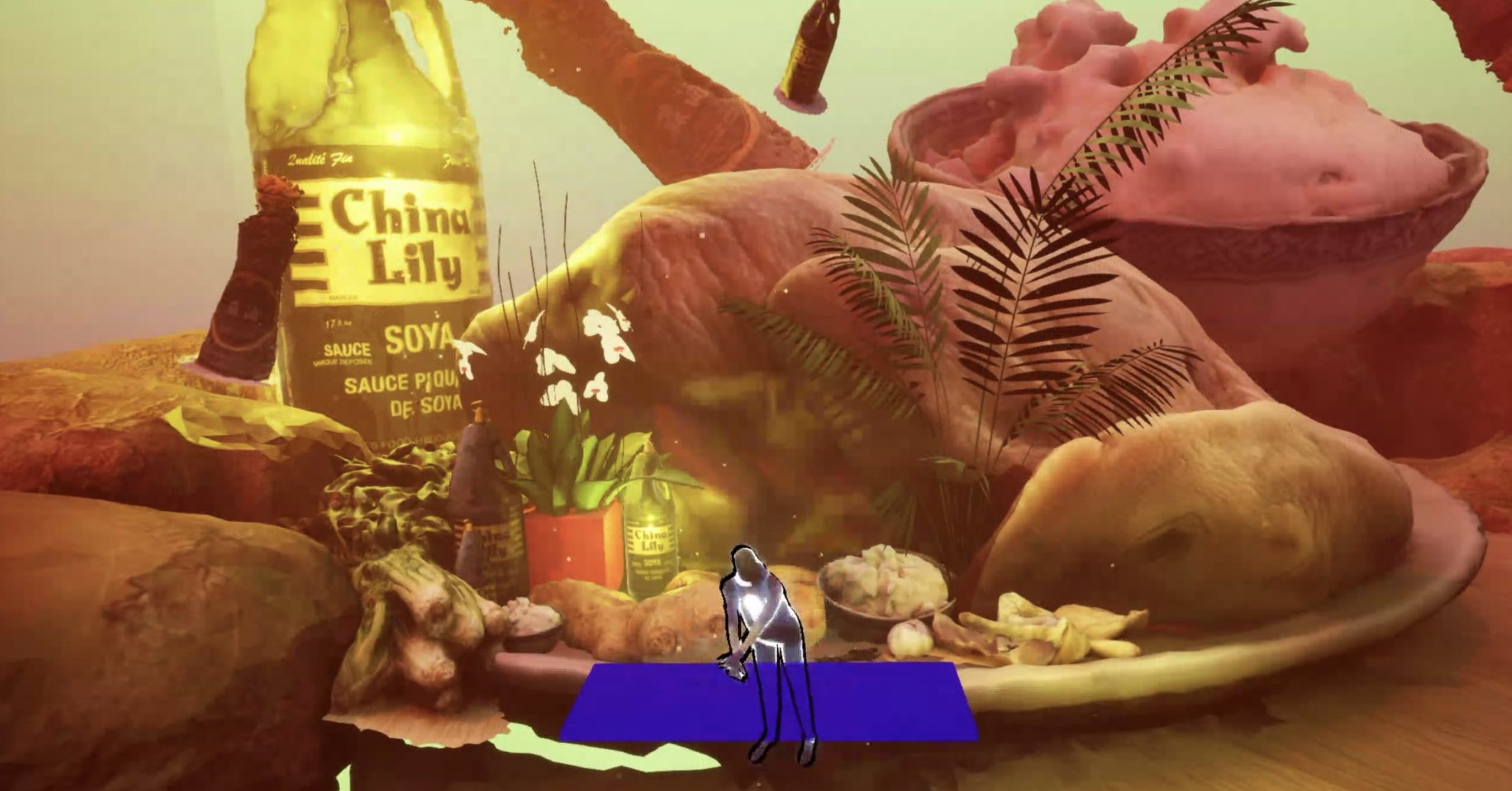
- This event has passed.
Passing Through the Heart: Episode 3
February 26, 2021 @ 5:00 pm– April 3, 2021 @ 6:00 pm EST

Friday, February 26, 6 pm ET
Free or suggested donation
Registration required. Click here to register.
Access information: This event will be live-streamed with automated closed captions. The Google Doc Q&A features screen reader and screen magnification support. If you encounter any issues, please send us a text message at 716-427-4125.
Passing Through the Heart, Episode 3 from Squeaky Wheel on Vimeo.
Poached chicken with ginger and rice is the star of the third episode of Passing Through the Heart. Presented by Public Visualization Studio (PVS), and guest starring artist and cook Cheng Yang “Bryan” Lee and food journalist Evelyn Kwong, this multi-media art and cooking show will be accompanied by a conversation on immigrant and refugee knowledge sharing, animated with PVS’ motion capture tools. You’re invited to watch, cook, and ruminate on how food is intertwined with memory and heritage in this live virtual episode. Episode 3 is co-presented with El Museo. Special thank you to our media sponsor Yelp.
Audiences will be able to leave reactions, comments, and questions through a shared Google Doc. Instructions for how to view and participate in the event will be communicated via email. The event will be available to register and view for 24 hours. SW members will have access to the event for 72 hours.
Passing through the Heart is a multi-media installation and series of virtual events by Public Visualization Studio that utilize non-optical motion capture, photogrammetry, videography, and audio recording come together to create a dialogue about migration, community, political conflicts, mourning, healing, and transformation.
Poached Chicken with rice and ginger sauce by Cheng Yang “Bryan” Lee
Ingredients
- 1 whole chicken (3 to 4 pounds)
- ginger
- scallion
- garlic
- cucumber
- cilantro
- rice
- oil
Recipe
- Clean the chicken: remove any stray feathers, rinse both the exterior and the cavity, and pat dry.
Lightly salt the chicken all over and set aside for at least 15 minutes, up to 1 hour.
Bring a large pot of water to just a simmer, and add a few scallions and slices of ginger.
Holding the chicken either by the neck (if attached) or with tongs (careful not to rip the skin), submerge the chicken in the hot water, swirl it around for a few seconds, then remove and let water drain back into the pot. Repeat this
dipping process a few times, allowing the water to come back up to temperature if needed. The skin of the chicken will start to look tight and smooth and slightly opaque.
Return the chicken to the pot, cover, and adjust the heat to maintain a water temperature of about 180-185F (82-85C). Do not let the water boil or you will end up with chicken soup.
Poach for 40 minutes to 1 hour depending on size of chicken.
If you’re not sure whether it’s cooked, you can test with a thermometer (175F in the thickest part of the thigh), but ideally you shouldn’t pierce the chicken at this point.
Carefully transfer chicken to a large bowl of ice water to chill completely. Do not discard the cooking broth. - While the chicken cools, make the rice.
Rinse and drain jasmine (or other medium-grain) rice, then use the chicken cooking broth instead of water to cook the rice.
Optional step: Saute minced garlic in some oil until fragrant, add the rice and stir to coat, before adding to rice cooker. - Now, make the ginger sauce.
Peel and roughly chop a lot of ginger.
Using a food processor, blitz the ginger to a fine texture. It will start to give off some liquid, and there should be no more long fibers remaining. Transfer the ginger to a heatproof bowl.
Press the ginger to squeeze out most of the juice. It does not have to be totally dry, but too much ginger juice will make the sauce too spicy.
Using same food processor, finely mince 1 or 2 scallions and add to ginger. Season with some salt.
Heat up a few tablespoons of peanut or vegetable oil in a small skillet or saucepan until it is extremely hot and begins to smoke.
Pour the oil slowly all over the ginger mixture and stir. It should sizzle vigorously and form a paste.
Add some of the chicken cooking broth to adjust the consistency, and more salt if desired. - When the chicken is fully cooled, the skin should have a firm, snappy bite, and the meat will be succulent with jellied chicken juices.
Carve and arrange on a platter with sliced cucumbers and chopped cilantro. Serve with rice. The cooking broth also makes a good side soup (add some salt and garnish with cilantro/scallion).
In addition to the ginger sauce, the chicken goes well with soy sauce, various chili sauces, or fish sauce.
Bios of the artists
Cheng Yang “Bryan” Lee is the curator at El Museo, a contemporary arts organization that focuses on underserved artists and communities in Buffalo and Western New York. Originally from Malaysia, he is a graduate of the University at Buffalo.
Evelyn Kwong is a journalist based in Toronto whose passion is covering inequities, stories on identity, and spotlighting voices that are often unheard. Growing up raised by a single-mother (and watching her do three jobs to put food on the table for a family of 3), her inspirations to fight for equity came from discovering her own identity as a Chinese-Canadian woman, overcoming abuse as a survivor, and being introduced to mental health struggles earlier on in her life. Due to those life experiences, she decided to go into journalism as a career to provide a platform for those who feel voiceless. Her latest work as an editor of the Star is leading the charge on the opinion column “In Their Own Voices” where she takes stories, experiences, opinions on identity with an intersectional lens from humans across Canada.
Immony Mèn is an artist, educator, and community-based researcher. He is an Assistant Professor of Interaction Design in the Faculty of Liberal Arts & Sciences and School of Interdisciplinary Studies at OCAD University.
Patricio Dávila is a designer, artist, researcher and educator. He is Associate Professor, Cinema and Media Arts, and core member of Vision: Science to Applications (VISTA) at York University.
Public Visualization Studio is a design collective whose members are designers, artists, creative technologists and researchers. The collective creates projects as a means to pursue inquiries into the political and conceptual aspects of interaction, space and media. Its members attempt to investigate how specific technologies of vision, communication and gesture support our experiences in participatory spaces. Members of the collective have exhibited nationally and internationally, and have worked in a variety of areas including public projection, media architecture, locative media, video installation, exhibition design, interaction, communication design and media scholarship. PVS works in collaboration with the Public Visualization Lab, a university-based lab in Toronto. PVS founding members are Patricio Dávila, Dave Colangelo, and Immony Mèn. PVS is located in Toronto, Canada.
El Museo![]() is a 501(c)3 nonprofit, professionally directed visual arts organization dedicated to the exhibition of contemporary work by underserved artists, and cultural programming that engages diverse communities through the arts and humanities. More information about El Museo here.
is a 501(c)3 nonprofit, professionally directed visual arts organization dedicated to the exhibition of contemporary work by underserved artists, and cultural programming that engages diverse communities through the arts and humanities. More information about El Museo here.
 Special thank you to our media sponsor Yelp.
Special thank you to our media sponsor Yelp.

